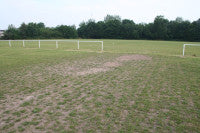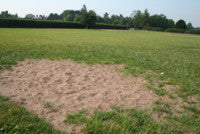How successful have your end of season renovations been?
How successful have your end of season renovations been?
By Laurence Gale MSc

With less than eight weeks to go before the main football season starts for most schools and clubs in the UK, how effective have your renovations been? If the works I have witnessed are anything to go by, we will see a lot of poor pitches during the forthcoming season. The goal mouth repairs have been poor, and I ask myself why bother if you're not prepared to ensure the work you undertake is successfully maintained to reach the desired outcome.
As you can see from the pictures the results of these endeavours is poor. Little or no germination of any of the seed applied, ground levels are poor and the pitch is infested with weeds. Perhaps the recent dry weather and high temperatures are to blame for the failure of seed germination, however, most local authorities do have watering

|

|
appliances which they could utilise at least for the initial establishment..
The overall appearance of these pitches is also poor, it's no wonder there is a decline in sport participation by the youth of today. Who on earth would be motivated or inspired to play on these pitches next season?
I personally blame the authorities for letting go of their parks managers, people who in the past had an affinity with and experience of managing sports facilities. Today Local Authority (LA) priorities have changed with little emphasis being placed on the provision of quality playing pitches.
This decline has come about as a result of the Compulsory Competitive Tendering (CCT) initiatives set by government back in the 1980's.
CCT required councils to have a better understanding of the costs of the services they provided by putting them out to tender. Unfortunately, one of the downsides was the erosion of traditional Groundsman skills and working practices. These days most LA's use contractors to carry out the end of season renovations. The problems arise with a lack of budgets and experienced manpower to first decide on the correct procedure and then to check its implementation. Invariably there's also never enough money to carry out all the necessary works, so often a compromise is taken, leading to the further detriment of the playing facilities.
Each year, when I was a parks officer, we had to find more cost savings to meet the budget for the following year. It always seemed to be Parks and Open spaces that carried the brunt of these financial cutbacks. A great many parks sections were also merged into larger departments managed by people who did not have an affinity with parks and open spaces. Often, whatever budgets were in place were ring fenced to other projects, which then further reduced the 'year on year' budgets available for grounds maintenance.
As a result of this ongoing loss of experienced parks and grounds managers who did have the skills and knowledge of managing sports facilities, we see the spiralling decline of sports surfaces in the UK.
During the last ten or so years Sport England has driven a number of initiatives to fund and provide facilities for clubs and schools, however, in the main, these have been structured around capital funding and do not incorporate clear ongoing maintenance schemes. Securing essential revenue resources is the key to the future of parks and school pitches, together with employing qualified and competent managers who can ensure these services are carried out effectively and to budget.
With so much talk about the 2012 Olympics and the drive for better sports facilities in the UK, I personally cannot see a reversing trend until we learn to nurture and retain the skilled personel and source robust long term revenue funding. Facilities, both new and old must meet the expectations and needs of our current and future end users.
The demise in pitch maintenance operations in the last 20 years has been woeful, it is little wonder that parks pitches are not being used to full potential. It used to be standard procedure to feed and weed twice annually, aerate monthly and water if required. These days, pitches are lucky to be cut more than once every two weeks and marked out.
I have coached kids in sport for many years and have definitely seen a drop in average fitness levels and co-ordination skills, mainly due to the lack of sport undertaken, perhaps a direct result of the poor facilities provided. I mean, who on earth gets a kick out of playing or training on poor quality pitches? To encourage sports participation, the improvement of natural grass facilities must be given greater importance.
If we want to encourage the next generation of Wayne Rooneys the process should start with decent grass roots level facilities, maintained appropriately to standards set by Government. All LA's should then be forced to adhere at least to a minimum standard or higher depending on the type and usage levels of each respective facility.

Ok, there will be a significant cost to provide this level of maintenance, maybe something around £5-8K per year per pitch, depending on the level of end of season renovations required. I am sure with the economies of scale taken across the UK this cost could be reduced further.
The long term benefits these quality pitches will bring for all is obvious, a healthier sport loving nation and a new generation of budding internationals. I am certain that there are many retired parks managers who are totally ashamed of the poor standard of current parks pitches, especially when you consider all the new technology available for pitch preparations.
